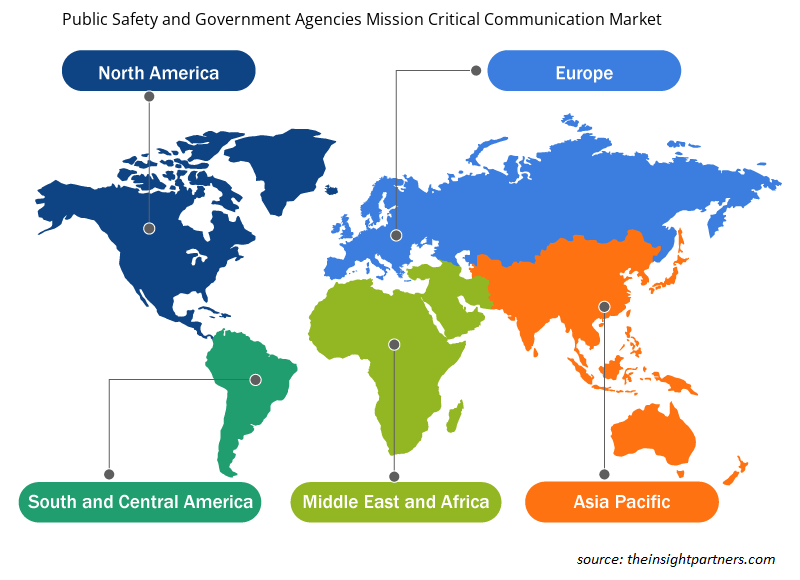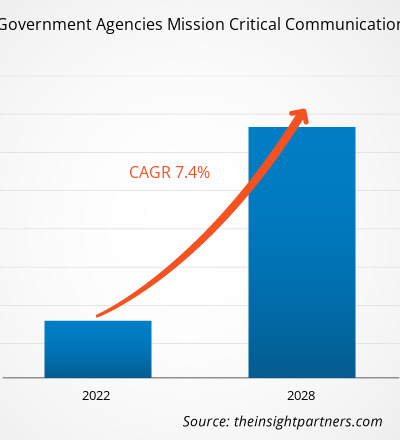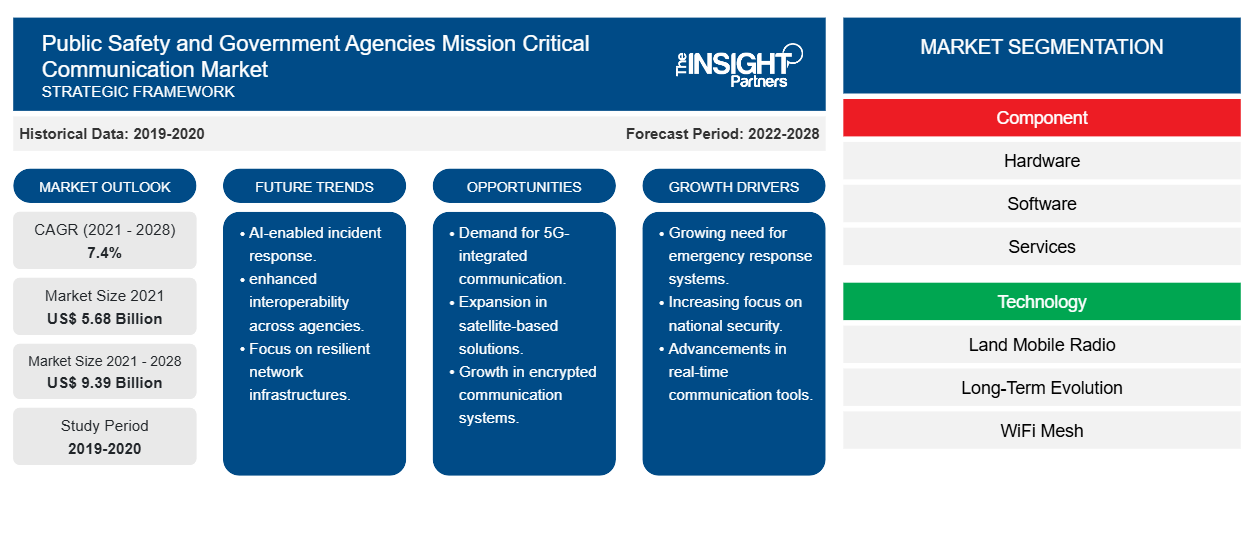公共安全および政府機関のミッションクリティカルな通信市場は、2021年に56億8,430万米ドルと評価され、2028年までに93億9,000万米ドルに達すると予測されています。また、2021年から2028年にかけて7.4%のCAGRで成長すると予想されています。
ミッションクリティカルな通信には、従来のシステムが要求を満たせない状況で、エンドユーザーへの通信方法を支援するソリューションが含まれます。また、公共安全および政府機関のミッションクリティカルな通信市場は、通信を促進し、人や財産に危険が伴う業務をサポートします。重要な通信デバイスは、重要な状況について人々を教育するために使用されます。公共安全および政府機関のミッションクリティカルな通信市場では、ネットワークオペレータは、ネットワークとサービスの急速な進化に対応して信頼性の高いネットワーク運用を保証するために、通信インフラストラクチャの新しい設計と管理戦略に重点を置いています。
COVID-19パンデミックが公共安全および政府機関のミッションクリティカル通信市場に与える影響
COVID-19 の流行は、北米の公共安全および政府機関のミッションクリティカルな通信市場に大きな影響を与え、最終用途産業に多大な経済的損失をもたらし、MCX 実装計画をさらに延期せざるを得なくなりました。この流行は、公共安全および政府機関のミッションクリティカルな通信市場のハードウェア製造現場の業務にも影響を与え、一時的な停止を余儀なくされました。その結果、いくつかの主要なコンポーネントサプライヤーとテクノロジープロバイダーがコストと生産量を削減しました。電子機器の需要は一定であったため、市場は成長を再開しました。
要件に合わせてレポートをカスタマイズする
このレポートの一部、国レベルの分析、Excelデータパックなど、あらゆるレポートを無料でカスタマイズできます。また、スタートアップや大学向けのお得なオファーや割引もご利用いただけます。
-
このレポートの主要な市場動向を入手してください。この無料サンプルには、市場動向から見積もりや予測に至るまでのデータ分析が含まれます。
市場洞察
さまざまな政府機関からの需要の高まりが、公共安全および政府機関のミッションクリティカルな通信市場の成長を促進
国民は政府機関から24時間のサービスと通信を期待しています。国民は、正確で最新の情報に簡単にアクセスし、適切な政府職員とスムーズに連絡を取りたいと考えています。また、サービスが迅速かつ効果的かつ透明に提供され、問題が迅速かつ効果的かつオープンに解決されることも望んでいます。多くの政府機関は、リースされたPBXシステムやセントレックスタイプのシステムなど、時代遅れの通信インフラストラクチャにまだ依存しています。また、公共安全および政府機関のミッションクリティカルな通信市場では、政府は公共の場で尊敬されるプレーヤーになるために優れた通信システムを開発および維持しています。上記の要因により、住民のニーズと好みを評価し、複数の利害関係者の関与、情報に基づいた政策討論、緊急開発の有効性のための審議的な公共の場を促進することができます。これらの問題はすべて、公共安全および政府機関のミッションクリティカルな通信市場の需要を促進します。
コンポーネントベースの市場分析
公共安全および政府機関のミッション クリティカルな通信市場のハードウェア コンポーネントには、コマンドおよびコントロール センター、ルーターとゲートウェイ、および配布管理システムが含まれます。ハードウェア コンポーネントの展開は、公共安全機関の性質によって異なります。世界中で報告される犯罪件数の増加により、公共安全および政府機関のミッション クリティカルな通信市場の需要が高まっています。
テクノロジーに基づく市場洞察
陸上移動無線 (LMR) は双方向無線とも呼ばれ、公共安全および政府機関のミッションクリティカルな通信市場で最も広く使用されている通信技術の 1 つです。この技術は継続的にテストと改良が行われており、特に公共安全における重要な通信の成功のベンチマークと見なされています。
公共安全および政府機関のミッションクリティカルな通信市場では、製品開発は企業が製品ポートフォリオを拡大するために一般的に採用する戦略であり、顧客基盤の拡大とブランド名の維持に役立ちます。市場における最近の重要な動向のいくつかは次のとおりです。
- 2021年、インドネシア共和国政府は、イリジウム コミュニケーションズ社から調達したイリジウム プッシュツートーク (PTT) デバイス 500 台を導入し、全国の通信業務を強化しました。インドネシア政府は現在、国内の多数の島嶼地帯での移動中の通信に適した、信頼性の高い「持ち運び可能な」リアルタイム衛星通信ソリューションを手に入れています。
- 2021年、インマルサットは、インドにおける戦略的パートナーであるBSNLが、インマルサットの世界クラスのGlobal Xpress(GX)モバイルブロードバンドサービスを提供するのに必要なライセンスを取得したことを確認しました。GXは、インド電気通信省からBSNLが取得した機内および海上接続(IFMC)ライセンスに基づき、政府、航空、海洋の各分野のインドの顧客に提供されます。
公共安全および政府機関向けミッションクリティカル通信市場地域別インサイト
予測期間を通じて公共安全および政府機関のミッションクリティカルな通信市場に影響を与える地域的な傾向と要因は、Insight Partners のアナリストによって徹底的に説明されています。このセクションでは、北米、ヨーロッパ、アジア太平洋、中東およびアフリカ、南米および中米にわたる公共安全および政府機関のミッションクリティカルな通信市場のセグメントと地域についても説明します。

- 公共安全および政府機関のミッションクリティカルな通信市場の地域固有のデータを入手
公共安全および政府機関向けミッションクリティカル通信市場レポートの範囲
| レポート属性 | 詳細 |
|---|---|
| 2021年の市場規模 | 56億8千万米ドル |
| 2028年までの市場規模 | 93億9000万米ドル |
| 世界のCAGR(2021年~2028年) | 7.4% |
| 履歴データ | 2019-2020 |
| 予測期間 | 2022-2028 |
| 対象セグメント |
コンポーネント別
|
| 対象地域と国 |
北米
|
| 市場リーダーと主要企業プロフィール |
|
公共安全機関および政府機関のミッションクリティカルな通信市場のプレーヤーの密度: ビジネスダイナミクスへの影響を理解する
公共安全および政府機関のミッションクリティカルな通信市場は、消費者の嗜好の変化、技術の進歩、製品の利点に対する認識の高まりなどの要因により、エンドユーザーの需要が高まり、急速に成長しています。需要が高まるにつれて、企業は提供を拡大し、消費者のニーズを満たすために革新し、新たなトレンドを活用し、市場の成長をさらに促進しています。
市場プレーヤー密度とは、特定の市場または業界内で活動している企業または会社の分布を指します。これは、特定の市場スペースに、その市場規模または総市場価値に対してどれだけの競合相手 (市場プレーヤー) が存在するかを示します。
公共安全および政府機関のミッションクリティカルな通信市場で事業を展開している主要企業は次のとおりです。
- アスコムホールディングAG(アスコム)
- グローバルスター
- インマルサット・グローバル・リミテッド
- イリジウムコミュニケーションズ株式会社
- 株式会社nbn
免責事項:上記の企業は、特定の順序でランク付けされていません。

- 公共安全および政府機関のミッションクリティカル通信市場の主要な主要プレーヤーの概要を入手
公共安全および政府機関のミッションクリティカルな通信市場のセグメンテーション:
コンポーネント別
- ハードウェア
- ソフトウェア
テクノロジー別
- ロングタームエボリューション(LTE)
- 陸上移動無線 (LMR)
- WiFiメッシュ
企業プロフィール
- アスコムホールディングAG(アスコム)
- グローバルスター
- インマルサット・グローバル・リミテッド
- イリジウムコミュニケーションズ株式会社
- 株式会社nbn
- SES SA
- テレサット
- スラーヤ通信会社
- AT&T 社
- スペースX
- 過去2年間の分析、基準年、CAGRによる予測(7年間)
- PEST分析とSWOT分析
- 市場規模価値/数量 - 世界、地域、国
- 業界と競争環境
- Excel データセット
最新レポート
お客様の声
購入理由
- 情報に基づいた意思決定
- 市場動向の理解
- 競合分析
- 顧客インサイト
- 市場予測
- リスク軽減
- 戦略計画
- 投資の正当性
- 新興市場の特定
- マーケティング戦略の強化
- 業務効率の向上
- 規制動向への対応























 無料サンプルを入手 - 公共安全および政府機関のミッションクリティカルな通信市場
無料サンプルを入手 - 公共安全および政府機関のミッションクリティカルな通信市場